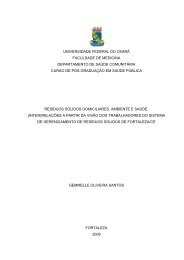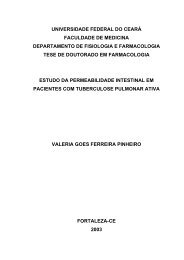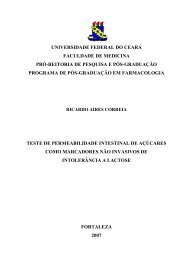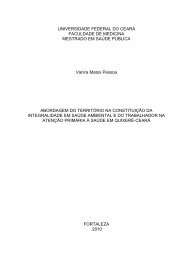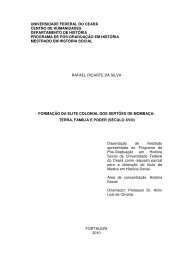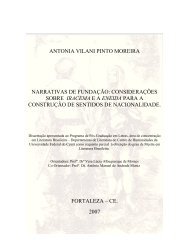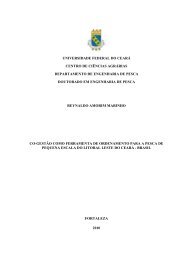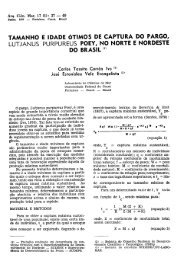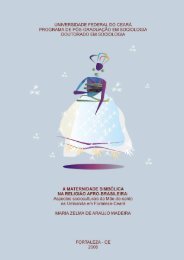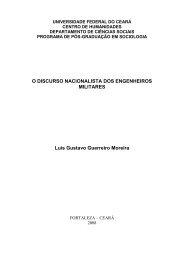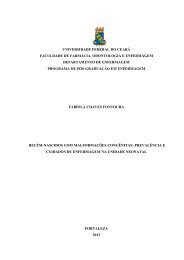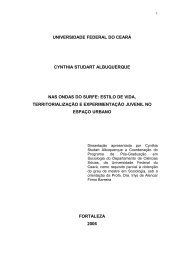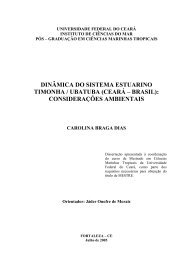Tungíase: doença negligenciada causando patologia grave
Tungíase: doença negligenciada causando patologia grave
Tungíase: doença negligenciada causando patologia grave
Create successful ePaper yourself
Turn your PDF publications into a flip-book with our unique Google optimized e-Paper software.
indirect disease markers and described diagnostic performances<br />
based on these individual markers and their<br />
combinations.<br />
MATERIALS AND METHODS<br />
A survey was conducted in the four schools of the<br />
Ilobu and Erin-Osun communities, which consist of two<br />
contiguous villages with similar socio-economic and cultural<br />
characteristics in the Osun State of Southwestern<br />
Nigeria. The detailed characteristics of these communities<br />
have previously been described (Ugbomoiko et al.<br />
2009, unpublished observations). Briefly, both communities<br />
border the Erinle Dam, which was constructed in<br />
the 1990s and is used principally for flood control, fishing<br />
and as a water supply. The communities are provided<br />
with primary and secondary schools, health centres and<br />
functional boreholes. The approximately 5,000 inhabitants<br />
of both communities are predominantly subsistence<br />
farmers and petty traders of the Yoruba ethnic group.<br />
All schoolchildren, from both primary and secondary<br />
schools, were eligible for this study. After giving consent,<br />
the participants received pre-labelled screw-capped plastic<br />
containers for urine collection. To avoid false positive<br />
results, girls of child-bearing age who had menstruated<br />
within five days before sample collection were excluded<br />
from analysis. The freshly passed mid-day urine samples<br />
(collected between 10-14 h) were inspected macroscopically<br />
for gross haematuria and then screened for microhaematuria<br />
and proteinuria using commercially available<br />
urine reagent strips (medi-Test Combi 9, Analyticon Biotechnologies,<br />
Germany). The strip testing was performed<br />
in accordance with the manufacturer’s instructions. The<br />
specimens were then transported to the laboratory within<br />
4 h of collection and processed for microscopic examination<br />
of schistosome eggs.<br />
Processing and egg counting followed the syringe<br />
filtration technique, which we considered the gold standard<br />
for diagnosis of schistosomiasis (Guyatt et al. 1999,<br />
WHO 1983, Lengeler et al. 1993). Two subsamples of 10<br />
mL were drawn into plastic syringes from each wellmixed<br />
sample and strained through a nylon filter. The<br />
filter was then examined under the microscope, and S.<br />
haematobium eggs were counted.<br />
Data were entered into an Excel spreadsheet, checked<br />
for entry errors and transferred into SPSS for Windows<br />
(version 11.0, SPSS Inc, Chicago, USA) for analysis. The<br />
sensitivity (number of individuals with a positive rapid<br />
test/individuals with a positive reference test), specificity<br />
(number of individuals with a negative rapid test/individuals<br />
with a negative reference test), the negative predictive<br />
value (probability that an individual with a negative rapid<br />
test is, in fact, free from disease) and the positive predictive<br />
value (probability that an individual with a positive<br />
rapid test is, in fact, diseased) were calculated for different<br />
combinations of rapid tests, as compared to the gold<br />
standard. Chi-square and ANOVA tests were applied to<br />
compare relative frequencies and the arithmetic means of<br />
egg counts between groups, respectively.<br />
Ethics - At the time of this study, a formal ethical<br />
committee in state of Osun did not exist. Permission to<br />
Rapid assessment of urinary schistosomiasis • Uade Samuel Ugbomoiko et al. 457<br />
perform this study was obtained from the local governments,<br />
community leaders and school heads. Informed<br />
consent was obtained from the study participants and<br />
their parents after a detailed explanation of the objectives<br />
of the study. All infected schoolchildren were referred<br />
to medical personal in the Area Office for praziquantel<br />
treatment.<br />
RESULTS<br />
In total, 447 schoolchildren and pre-schoolchildren<br />
were included in this study. Among the participants,<br />
248 (56%) were male and the median age was 11 years<br />
(interquartile range: 9-13 years; range: 3-17 years).<br />
Prevalence and intensity of urinary schistosomiasis are<br />
depicted in Table I. The prevalence was significantly<br />
higher in Ilobu village. In boys, prevalence of infection<br />
was significantly higher than in girls and the mean<br />
egg count was approximately twice as high; however,<br />
the difference was not statistically significant (Table<br />
I). The prevalence increased significantly with age and<br />
showed a peak in participants who were ! 15 year-olds,<br />
with 78% of individuals infected.<br />
Table II depicts the sensitivity, stratified by intensity<br />
of infection, of macrohaematuria, microhaematuria, proteinuria<br />
and their combinations in the diagnosis of urinary<br />
schistosomiasis. In general, sensitivities were low, but increased<br />
with severity of infection. In almost all patients<br />
presenting with heavy infection (95%), microhaematuria<br />
was observed. In contrast, macrohaematuria was detected<br />
in only 45% of the total of patients with schistosomiasis<br />
(Table II). Considering the rapid assessment as positive in<br />
the presence of macrohaematuria or, alternatively, in the<br />
presence of concomitant microhaematuria and proteinuria,<br />
an overall sensitivity of 63% and of 90% in heavy infections<br />
was revealed.<br />
In Table III, the diagnostic performance values of the<br />
indicators macrohaematuria, microhaematuria, proteinuria<br />
and their different combinations are given using the<br />
presence of eggs in urine as the gold standard for diagnosis.<br />
The highest overall sensitivity was found for microhaematuria<br />
(68%), with a specificity of 83%. However,<br />
the specificity was highest (96%) when the concomitant<br />
presence of microhaematuria and proteinuria was used<br />
as an infection marker. Macrohaematuria also showed a<br />
very high specificity and positive predictive value (96%<br />
and 92%, respectively), but sensitivity was less than 50%<br />
(Table III). To combine the benefits of all diagnostic approaches,<br />
we assessed the accuracy of the concomitant<br />
presence of macrohaematuria or the presence of microhaematuria<br />
and proteinuria. This improved sensitivity to<br />
63% while maintaining a high specificity of 93% (Table<br />
III) and it indicates that there were 37% false negative and<br />
7% false positive results. In contrast, using a rapid test<br />
based merely on the presence of microhaematuria and<br />
proteinuria, or on the presence of macrohaematuria, resulted<br />
in a proportion of false negative results as high as<br />
62% and 55%, respectively.<br />
DISCUSSION<br />
Our data show that combining indirect disease marker<br />
information obtained from both urine reagent strip



